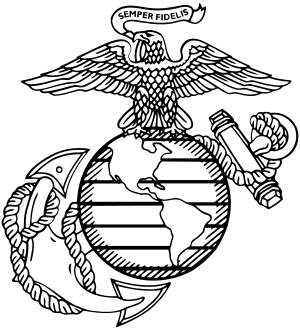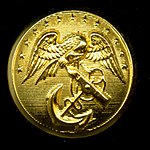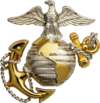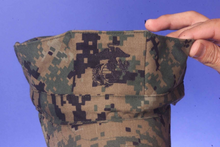
The flag of the United States Marine Corps is the flag used to represent the U.S. Marine Corps, as well as its subsidiary units and formations.
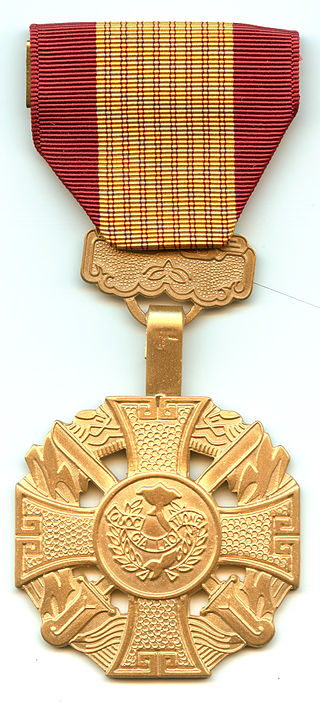
The Republic of Vietnam Gallantry Cross also known as the Vietnamese Gallantry Cross or Vietnam Cross of Gallantry is a military decoration of the former Government of South Vietnam. The medal was created on August 15, 1950, and was awarded to military personnel, civilians, and Armed Forces units and organizations in recognition of deeds of valor or heroic conduct while in combat with the enemy.

Jacob Zeilin was the United States Marine Corps' first non-brevet flag officer. He served as the seventh commandant of the United States Marine Corps, from 1864 to 1876.

The sergeant major of the Marine Corps is a billet, as well as a unique enlisted grade of rank, and is designated a special paygrade above E-9. The position also has a unique non-commissioned grade of rank insignia, in the United States Marine Corps. The holder of this rank and position is the most senior enlisted marine in the Marine Corps, unless an enlisted marine is serving as the senior enlisted advisor to the chairman, which is the case as of November 3, 2023.
The Air and Space Training Ribbon (ASTR) is the lowest military award of the United States Air Force and United States Space Force, ranking only above foreign military awards.

A cap badge, also known as head badge or hat badge, is a badge worn on uniform headgear and distinguishes the wearer's nationality and/or organisation. The wearing of cap badges is a convention commonly found among military and police forces, as well as uniformed civilian groups such as the Boy Scouts, civil defence organisations, ambulance services, customs services, fire services etc.
The Fleet Marine Force Warfare Insignia, also known as the Fleet Marine Force badge or FMF pin, are three military badges of the United States Navy which are issued to those U.S. Navy officers and sailors who are trained and qualified to perform duties in support of the United States Marine Corps. There are currently three classes of the Fleet Marine Force pin, being that of enlisted, officer, and chaplain.

The Battle Dress Uniform (BDU) is a camouflaged combat uniform that was used by the United States Armed Forces as their standard combat uniform from the early 1980s to the mid-2000s. Since then, it has been replaced or supplanted in every branch of the U.S. Armed Forces.

Insignias and badges of the United States Navy are military badges issued by the United States Department of the Navy to naval service members who achieve certain qualifications and accomplishments while serving on both active and reserve duty in the United States Navy. Most naval aviation insignia are also permitted for wear on uniforms of the United States Marine Corps.

Insignia and badges of the United States Marine Corps are military "badges" issued by the United States Department of the Navy to Marines who achieve certain qualifications and accomplishments while serving on both active and reserve duty in the United States Marine Corps.

A peaked cap, peaked hat, service cap, barracks cover, or combination cap is a form of headgear worn by the armed forces of many nations, as well as many uniformed civilian organisations such as law enforcement agencies and fire departments. It derives its name from its short visor, or peak, which was historically made of polished leather but increasingly is made of a cheaper synthetic substitute.

The Command at Sea insignia is a badge of the United States' seagoing services worn by officers on their uniforms to denote that they are the commander, or formerly a commander, of a warship. If the wearer is currently the commander of a warship, it is worn above the nametag, which is worn a quarter of an inch above the right chest pocket on a uniform shirt. Afterwards, the pin is moved to the left side of the shirt or jacket. For the commanders of land-based installations, a different but similar version known as the Command Ashore insignia instead.

The uniforms of the United States Navy include dress uniforms, daily service uniforms, working uniforms, and uniforms for special situations, which have varied throughout the history of the navy. For simplicity in this article, officers refers to both commissioned officers and warrant officers.

The Marine Military Academy (MMA) is a private college preparatory academy located in Harlingen, Texas, US, offering a curriculum for boys in grades 7–12 plus one year of post-graduate study. The school was founded in 1965. Its traditions and ideals are inspired by the United States Marine Corps (USMC), but the school is not affiliated with the USMC except through its Junior ROTC program.

The United States Marine Corps (USMC) prescribes several types of military uniform to distinguish its service members from other armed services, depending on the situation.

United States Marine Corps rank insignia are the devices worn by officers in the United States Marine Corps, in order to provide distinction from other ranks. Different styles of rank insignia are worn on different uniforms of the United States Marine Corps.
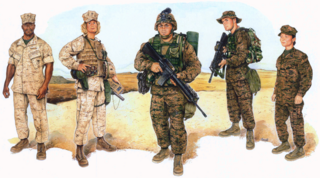
The Marine Corps Combat Utility Uniform (MCCUU) is the current battledress uniform of the United States Marine Corps. It is also worn by Navy personnel assigned to Marine Corps units.
The culture of the United States Marine Corps is widely varied but unique amongst the branches of the United States Armed Forces. Because members of the Marine Corps are drawn from across the United States, it is as varied as each individual Marine but tied together with core values and traditions passed from generation to generation of Marines. As in any military organization, the official and unofficial traditions of the Marine Corps serve to reinforce camaraderie and set the service apart from others. The Corps' embracement of its rich culture and history is cited as a reason for its high esprit de corps.

The National Oceanic and Atmospheric Administration Commissioned Officer Corps, one of the eight uniformed services of the United States, has the authority to issue various awards and commendations to its members. These include individual honor awards, unit honor awards, service awards, training ribbons and qualification insignia. NOAA Corps awards and decorations include:
